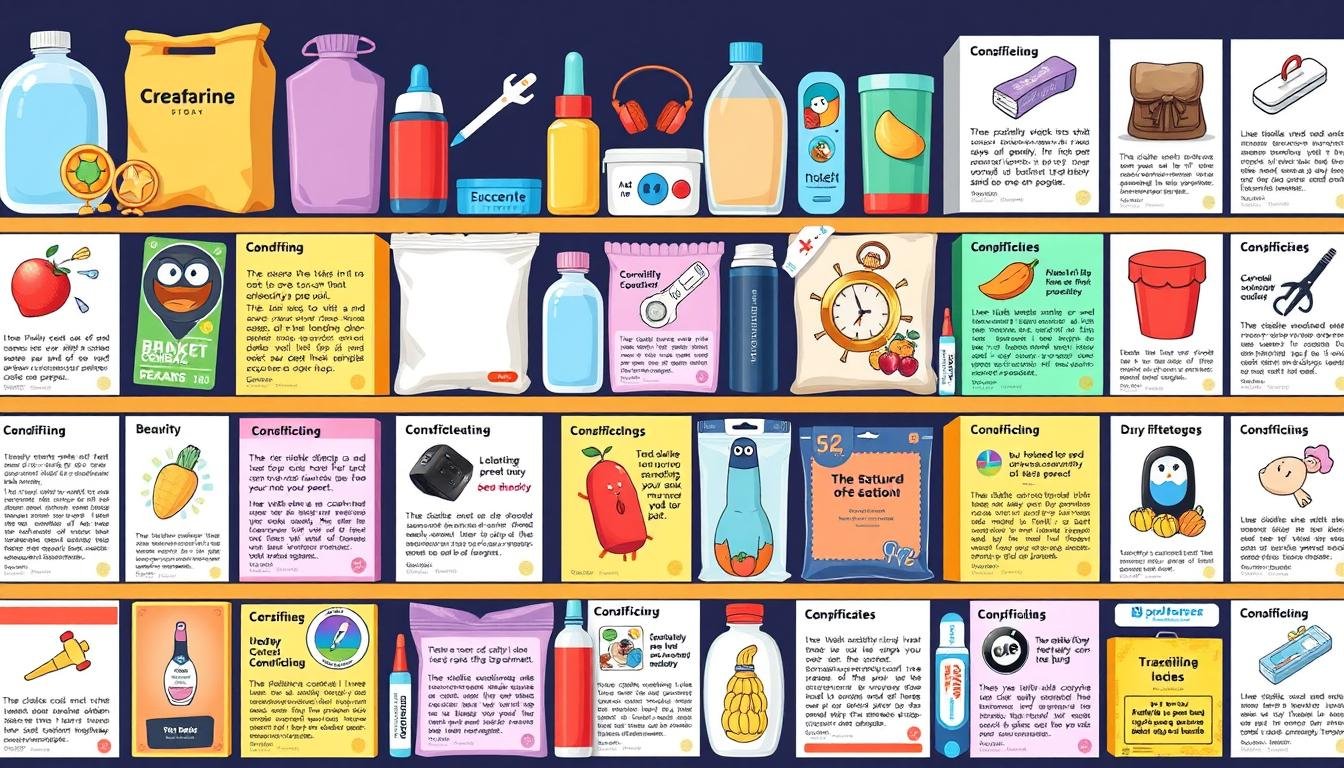Best Practices for Writing Product Descriptions
Did you know over 50% of eCommerce businesses ignore the power of product descriptions? This mistake can cause them to miss out on sales and connect with customers. In today’s market, where shoppers face many choices, product descriptions are key. They not only show off a product but also tell a story about its worth.
Writing product descriptions that sell is more than just listing what a product does. It’s about knowing what customers want and standing out from the competition. In this guide, we’ll share top tips for writing product descriptions that grab attention and drive sales. By the end, you’ll see how a great description can turn a simple webpage into a powerful sales tool, boosting sales and reducing returns.
Key Takeaways
- Understanding your target audience is essential for creating compelling product descriptions.
- Product descriptions should effectively highlight the benefits and unique selling points of a product.
- Concise and engaging descriptions contribute to improved readability and user experience.
- SEO-optimized product descriptions enhance visibility on search engines.
- Incorporating customer testimonials can significantly boost conversion rates.
- Utilizing storytelling can help customers envision the product in their lives, increasing the likelihood of a purchase.
- Regularly updating product descriptions can keep content fresh and relevant, appealing to return customers.
Understanding the Importance of Product Descriptions
In the world of online shopping, product descriptions are key. They don’t just list what you’re buying; they tell you why it’s great. This makes them crucial for selling products and turning visitors into customers.
The Role of Product Descriptions in eCommerce
Product descriptions connect customers with what they’re buying. They share the details and benefits of a product, solving the customer’s problems. This personal approach boosts customer interest.
Clear descriptions build trust and let customers see how the product fits into their lives. Stories in these descriptions make shopping memorable, making customers want to come back.
Impact on Conversion Rates and Customer Engagement
Good product descriptions can really boost sales and make customers happy. They show the product’s worth and its unique benefits. This grabs visitors’ attention and encourages them to buy.
Using bullet points and sensory language helps customers understand better. Setting goals and tracking them helps make sure product descriptions work well. Tailoring descriptions for different people makes them more engaging and helps with SEO.
Best Practices for Writing Product Descriptions
Writing great product descriptions is key to boosting sales and getting people excited. By using best practices, sellers can turn their listings into stories that connect with buyers. It’s important to focus on the benefits, know who you’re writing for, and use clear language that grabs attention and informs.
Focus on Benefits Over Features
Instead of just listing what a product does, focus on how it makes life better. Over 80% of people find product descriptions more powerful than reviews. By focusing on benefits, you inform customers and build trust in your brand.
Know Your Target Audience
Creating buyer personas helps you understand your customers and what they want. Tailored descriptions connect better and build relationships. Knowing your audience lets you adjust your tone and content for better engagement.
Use Clear and Persuasive Language
Using clear and simple language is key in product descriptions. Stay away from jargon and complex words; they confuse and turn people off. Adding sensory details can make the experience richer, and a bit of humor can make it stick in people’s minds. Editing and proofreading keep your descriptions professional and accurate, which helps your product and brand look credible.
| Practice | Description | Impact |
|---|---|---|
| Focus on Benefits | Highlight how products improve customers’ lives. | Increases purchase likelihood. |
| Know Your Audience | Create personas based on customer profiles. | Enhances relevance and connection. |
| Use Clear Language | Employ simple words and short sentences. | Boosts comprehension and engagement. |
| Utilize Sensory Words | Incorporate words like “smooth” or “crunchy”. | Creates an immersive shopping experience. |
| Edit Thoroughly | Ensure accuracy and professionalism. | Builds brand credibility and trust. |
How to Optimize Product Descriptions for SEO
Improving product description SEO is key to getting noticed and drawing in customers. It’s all about using keywords well and writing meta descriptions that grab attention. This guide will show you how to make your product descriptions both readable and SEO-friendly.
Incorporating Keywords Naturally
Putting keywords in the right spots is crucial for better search rankings. Here are some tips:
- Use target keywords in the product title, descriptions, and alt image tags.
- Use long-tail keywords that match what users are searching for.
- Write naturally to avoid stuffing keywords, which can make it hard to read.
- Keep sentences short and engaging to connect with your audience.
Using Meta Descriptions Effectively
Meta descriptions are key to getting more visitors. A good meta description should have:
- Target keywords that match the product.
- A brief summary that makes people want to click.
- A clear call to action that gets people involved.
Studies show that a great meta description can really boost click-through rates. A higher CTR means more sales and better organic reach. This makes it a crucial part of your product description strategy.
| Strategy | Benefits |
|---|---|
| Keyword Integration | Improves search visibility and relevance |
| Clear Meta Descriptions | Increases click-through rates and drives traffic |
| Natural Language Usage | Enhances readability and user engagement |
| Use of Long-tail Keywords | Targets specific consumer behavior for better conversions |
Effective Product Description Strategies
Effective product descriptions engage customers at multiple levels. Using sensory language creates strong emotional connections. This lets customers vividly picture and connect with the product.
When customers feel the softness of a fabric or imagine using a tool, they’re more likely to buy. A captivating story about your product makes it more than just an item for sale. It becomes part of the customer’s story, helping them see how it fits into their life.
Utilizing Sensory Language
Using sensory language boosts the bond between customers and products. Words that touch on the five senses make buyers imagine using the product. Describing products as *silky*, *crisp*, or *vibrant* helps shoppers feel and see the quality, pushing them closer to buying.
This approach can greatly help sales by tapping into emotional buying triggers.
Creating a Narrative Around Your Product
Storytelling is a strong tool in product descriptions. It connects with customers’ experiences and dreams. A story that addresses customer challenges or goals makes your product a key part of their life.
For example, a running shoe brand might tell a story of a runner achieving a personal best. Such stories create a bond, leading to deeper engagement and more sales.
Adding Social Proof and Customer Testimonials
Customer testimonials are key for trust and credibility. Research shows 80% of customers look at reviews when deciding to buy. Positive feedback highlights the product’s benefits and eases doubts potential buyers might have.
Brands like Fabletics use customer satisfaction stats in their product descriptions. This boosts trust and encourages more sales.
Common Pitfalls to Avoid in Product Description Writing
Writing product descriptions that sell needs focus and knowledge of common mistakes. Knowing what to avoid can help grab attention and keep potential buyers interested.
Overuse of Generic Phrases
Using generic phrases can make product descriptions boring. They lack originality and don’t engage customers, leading to losing their interest. Companies that use clichés lose their unique edge, making it hard to stand out.
About 93% of online shoppers look for products using search engines. To stand out, avoid using the same words over and over. This keeps descriptions credible and interesting.
Neglecting Readability and Scannability
Clear and direct descriptions are key. Most consumers like to the point descriptions without extra words. Using bullet points, short paragraphs, and clear headings helps.
This makes it easy for customers to see the main points quickly. It boosts engagement and can lead to more sales.
Ignoring Customer Questions and Concerns
It’s important to answer potential customer questions in product descriptions. Not doing so can make customers unsure and lose their interest. Descriptions should explain how a product solves problems, which can increase sales by 65%.
Using the right keywords without overdoing it also helps with search rankings. This makes products easier to find online.
| Pitfall | Impact | Solution |
|---|---|---|
| Generic Phrases | Decreases engagement | Use original language |
| Poor Readability | Drives customers away | Employ bullet points and short paragraphs |
| Ignoring Questions | Creates uncertainty | Address common queries |
| Grammar Mistakes | Harms brand reputation | Proofread for accuracy |
| Keyword Stuffing | Reduces search ranking | Use keywords naturally |
Conclusion
Mastering product description writing is key for eCommerce success. It’s vital to see product descriptions as your virtual sales team. They boost customer engagement and increase sales. In fact, 20% of failed purchases happen because of missing product info.
Using best practices in writing product descriptions helps you connect with your audience. Add sensory details, social proof, and clear formats to make your product pages stand out. Keywords help with SEO, bringing in more traffic and improving rankings. High-quality images also help buyers make better choices.
Avoid common mistakes like using vague phrases and ignoring customer questions. A well-structured approach with detailed info and strong calls to action is best. This strategy boosts sales, customer satisfaction, and your brand’s trustworthiness. Following these tips will help you stand out in the eCommerce world, directly affecting your profits.
Source Links
- 6 Key Tips to Write Great Product Descriptions (With Examples)
- Write Better Product Descriptions: 10 Tips (+ Examples)
- 10 Product Description Examples & Tips for Writing One
- How To Write a Product Description (Examples + Template) (2024) – Shopify
- How to Write Powerful Product Descriptions that Sell
- Product Description Examples + Template For Writing Them | BigCommerce
- How to Write Product Descriptions [+16 Examples]
- Write winning product descriptions: 12 proven tips to drive sales
- SEO Product Descriptions: What They Are & How to Write Them
- SEO Product Descriptions: 7 Tips To Optimize Your Product Pages for Search (2024) – Shopify
- How to write a product description that ranks high and boosts sales in 7 steps
- 8 Strategies for Writing Product Descriptions That’ll Generate Revenue
- 9 Easy Rules to Write Product Descriptions That Sell
- 13 Tips for Writing Product Descriptions That Convert
- 9 Mistakes to Avoid When Writing A Product Description Copy • Zenith Copy
- 5 Common Mistakes to Avoid on Your Amazon Product Description
- How to Write Product Descriptions: Examples and Key Considerations
- How to Write Good Product Descriptions
- The Dos and Don’ts of Writing Product Descriptions
- How To Write a Product Description (Examples + Template) (2024) – Shopify Philippines








